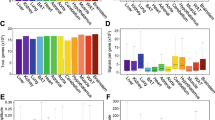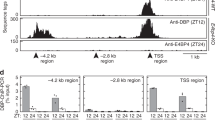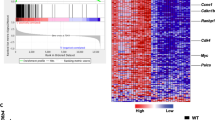Abstract
Mammalian circadian clocks consist of complex integrated feedback loops1,2,3,4,5,6,7,8,9,10 that cannot be elucidated without comprehensive measurement of system dynamics and determination of network structures11. To dissect such a complicated system, we took a systems-biological approach based on genomic, molecular and cell biological techniques. We profiled suprachiasmatic nuclei and liver genome-wide expression patterns under light/dark cycles and constant darkness. We determined transcription start sites of human orthologues for newly identified cycling genes and then performed bioinformatical searches for relationships between time-of-day specific expression and transcription factor response elements around transcription start sites. Here we demonstrate the role of the Rev-ErbA/ROR response element in gene expression during circadian night, which is in phase with Bmal1 and in antiphase to Per2 oscillations. This role was verified using an in vitro validation system, in which cultured fibroblasts transiently transfected with clock-controlled reporter vectors exhibited robust circadian bioluminescence12.
This is a preview of subscription content, access via your institution
Access options
Subscribe to this journal
Receive 51 print issues and online access
$199.00 per year
only $3.90 per issue
Buy this article
- Purchase on Springer Link
- Instant access to full article PDF
Prices may be subject to local taxes which are calculated during checkout





Similar content being viewed by others
References
King, D. P. et al. Positional cloning of the mouse circadian clock gene. Cell 89, 641–653 (1997)
Bunger, M. K. et al. Mop3 is an essential component of the master circadian pacemaker in mammals. Cell 103, 1009–1017 (2000)
Zheng, B. et al. Nonredundant roles of the mPer1 and mPer2 genes in the mammalian circadian clock. Cell 105, 683–694 (2001)
van der Horst, G. T. et al. Mammalian Cry1 and Cry2 are essential for maintenance of circadian rhythms. Nature 398, 627–630 (1999)
Lowrey, P. L. et al. Positional syntenic cloning and functional characterization of the mammalian circadian mutation tau. Science 288, 483–492 (2000)
Gekakis, N. et al. Role of the CLOCK protein in the mammalian circadian mechanism. Science 280, 1564–1569 (1998)
Jin, X. et al. A molecular mechanism regulating rhythmic output from the suprachiasmatic circadian clock. Cell 96, 57–68 (1999)
Kume, K. et al. mCRY1 and mCRY2 are essential components of the negative limb of the circadian clock feedback loop. Cell 98, 193–205 (1999)
Shearman, L. P. et al. Interacting molecular loops in the mammalian circadian clock. Science 288, 1013–1019 (2000)
Yu, W., Nomura, M. & Ikeda, M. Interactivating feedback loops within the mammalian clock: BMAL1 is negatively autoregulated and upregulated by CRY1, CRY2, and PER2. Biochem. Biophys. Res. Commun. 290, 933–941 (2002)
Kitano, H. Systems biology: a brief overview. Science 295, 1662–1664 (2002)
Chen, W., Ueda, H. R. & Hashimoto, S. In vitro determination of clock-controlled elements. Curr. Biol. (submitted)
Maruyama, K. & Sugano, S. Oligo-capping: a simple method to replace the cap structure of eukaryotic mRNAs with oligoribonucleotides. Gene 138, 171–174 (1994)
Clayton, J. D., Kyriacou, C. P. & Reppert, S. M. Keeping time with the human genome. Nature 409, 829–831 (2001)
Hida, A. et al. The human and mouse Period1 genes: five well-conserved E-boxes additively contribute to the enhancement of mPer1 transcription. Genomics 65, 224–233 (2000)
Paca-Uccaralertkun, S. et al. In vitro selection of DNA elements highly responsive to the human T- cell lymphotropic virus type I transcriptional activator. Tax. Mol. Cell Biol. 14, 456–462 (1994)
Obrietan, K., Impey, S., Smith, D., Athos, J. & Storm, D. R. Circadian regulation of cAMP response element-mediated gene expression in the suprachiasmatic nuclei. J. Biol. Chem. 274, 17748–17756 (1999)
Harding, H. P. & Lazar, M. A. The orphan receptor Rev-ErbA alpha activates transcription via a novel response element. Mol. Cell Biol. 13, 3113–3121 (1993)
Jetten, A. M., Kurebayashi, S. & Ueda, E. The ROR nuclear orphan receptor subfamily: critical regulators of multiple biological processes. Prog. Nucleic Acid Res. Mol. Biol. 69, 205–247 (2001)
Panda, S. et al. Coordinated transcription of key pathways in the mouse by the circadian clock. Cell 109, 307–320 (2002)
Duffield, G. E. et al. Circadian programs of transcriptional activation, signalling, and protein turnover revealed by microarray analysis of mammalian cells. Curr. Biol. 12, 551–557 (2002)
Akhtar, R. A. et al. Circadian cycling of the mouse liver transcriptome, as revealed by cDNA microarray, is driven by the suprachiasmatic nucleus. Curr. Biol. 12, 540–550 (2002)
Grundschober, C. et al. Circadian regulation of diverse gene products revealed by mRNA expression profiling of synchronized fibroblasts. J. Biol. Chem. 276, 46751–46758 (2001)
Storch, K. F. et al. Extensive and divergent circadian gene expression in liver and heart. Nature 417, 78–83 (2002)
McDonald, M. J. & Rosbash, M. Microarray analysis and organization of circadian gene expression in Drosophila. Cell 107, 567–578 (2001)
Ueda, H. R. et al. Genome-wide transcriptional orchestration of circadian rhythms in Drosophila. J. Biol. Chem. 277, 14018–14052 (2002)
Claridge-Chang, A. et al. Circadian regulation of gene expression systems in the Drosophila head. Neuron 32, 657–671 (2001)
Harmer, S. L. et al. Orchestrated transcription of key pathways in Arabidopsis by the circadian clock. Science 290, 2110–2113 (2000)
Cho, R. J. et al. Transcriptional regulation and function during the human cell cycle. Nature Genet. 27, 48–54 (2001)
Shigeyoshi, Y. et al. Light-induced resetting of a mammalian circadian clock is associated with rapid induction of the mPer1 transcript. Cell 91, 1043–1053 (1997)
Acknowledgements
We thank T. Kojima, T. Katakura and H. Urata for technical assistance. This study was performed as a part of a research and development project of the Industrial Science and Technology Program supported by NEDO (New Energy and Industrial Technology Development Organization).
Author information
Authors and Affiliations
Corresponding authors
Ethics declarations
Competing interests
The authors declare that they have no competing financial interests.
Rights and permissions
About this article
Cite this article
Ueda, H., Chen, W., Adachi, A. et al. A transcription factor response element for gene expression during circadian night. Nature 418, 534–539 (2002). https://doi.org/10.1038/nature00906
Received:
Accepted:
Issue Date:
DOI: https://doi.org/10.1038/nature00906
This article is cited by
-
Glucocorticoids coordinate the bladder peripheral clock and diurnal micturition pattern in mice
Communications Biology (2023)
-
Conservation of dynamic characteristics of transcriptional regulatory elements in periodic biological processes
BMC Bioinformatics (2022)
-
Sleep and circadian rhythms in Parkinson’s disease and preclinical models
Molecular Neurodegeneration (2022)
-
Rhythmic transcription of Bmal1 stabilizes the circadian timekeeping system in mammals
Nature Communications (2022)
-
Effect of combination of residual glucose concentration and subsequent increment by temporal glucose feeding on oscillation of clock gene Per2 expression
Cytotechnology (2022)
Comments
By submitting a comment you agree to abide by our Terms and Community Guidelines. If you find something abusive or that does not comply with our terms or guidelines please flag it as inappropriate.



